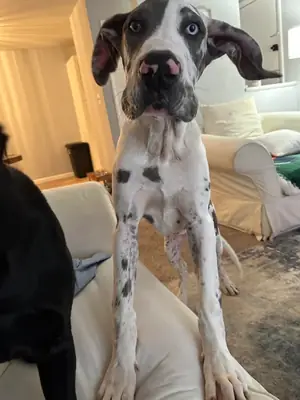Great Dane: Traits, Care, Nutrition, Health and 2026 Living Guide
The Great Dane balances elegance with giant stature. With 2026 tools—activity sensors, joint-friendly flooring, and growth-aware feeding—Danes can thrive even in cities. This article covers essentials from puppyhood to adulthood.
1. Breed Profile
- Origin: Germany
- Weight: M 54–90+ kg; F 45–70+ kg
- Height: M 80–86+ cm; F 72–82+ cm
- Lifespan: 8–10 years
- Temperament: Calm, people-oriented, gentle; can be protective
- Best fit: Spacious homes, time/budget planning, giant-breed experience
2. Housing & Climate
- Non-slip, cushioned floors (thick rugs, rubber tiles) to offload joints.
- Orthopedic bed to prevent elbow calluses and pressure sores.
- Indoor 18–24°C; cooling mats in summer, draft-free dry rooms in winter.
- Limit stairs; controlled ascent/descent during growth.
3. Exercise & Enrichment
3.1 Daily Volume
- Adults: 60–90 min moderate activity split into sessions.
- Puppy/adolescent (to 18 mo): short, frequent, low-impact walks; avoid jumping and sharp turns.
3.2 Mental Work
- Scent games, target training, controlled puzzle tasks.
- Use 2026 trackers for pace, load, and recovery insights.
4. Nutrition Strategy
For giants, during rapid growth energy must be moderated and calcium-phosphorus kept balanced.
| Component | Target | Examples | Benefits |
|---|---|---|---|
| Protein quality | 24–28% (puppy/adolescent), 22–26% (adult) | Turkey, salmon, lamb, egg | Lean mass and repair |
| Fat balance | 12–16% (age/activity dependent) | Fish oil, canola, flax | Energy, skin/coat, anti-inflammatory |
| Ca:P ratio | ~1.2–1.4:1 (per vet guidance) | Giant puppy/adult formulas | Skeletal development |
| Complex carbs | Moderate | Oats, brown rice, sweet potato | Steady energy, GI tolerance |
| Functional support | Targeted | Glucosamine, chondroitin, MSM, probiotics | Joint, gut, recovery |
Feed 2–3 meals/day; avoid large meals 60 min before/after intense exercise. Use slow-feeders and calm settings to reduce GDV risk.
5. Health & Screening
- GDV risk: High; discuss prophylactic gastropexy with your vet.
- Orthopedic: Hip/elbow dysplasia screening, weight control, low-impact exercise.
- Cardiac: Screen for dilated cardiomyopathy; annual auscultation/echo.
- GI/endocrine: Gradual diet transitions; consider probiotics.
- Dermatology: Elbow callus/pressure sore prevention with thick bedding.
6. Training & Behavior
- Positive reinforcement, short focused sessions, consistent rules.
- Reinforce recall, wait, and leave-it with high-value rewards.
- Early, structured socialization with people and pets.
7. Transport & Gear
- XL seat-belt harnesses; wide, non-slip crates.
- Plan water/cooling breaks every 2 hours on long trips.
- Microchip + QR ID + GPS tracker.
8. Frequently Asked Questions
Can a Great Dane live in an apartment?
Yes—with spacious layout, daily outdoor exercise, and limited stair use.
How do I reduce bloat (GDV) risk?
Multiple small meals, calm feeding, slow-feeder bowls, no heavy exercise around meals.
When to consider gastropexy?
Discuss prophylactic gastropexy at the time of spay/neuter for high-risk lines.
How much exercise is enough?
Adults 60–90 min/day; puppies short/frequent low-impact walks.
Are supplements necessary?
Glucosamine-chondroitin, MSM, omega-3s, and probiotics can help; confirm with your vet.
How often should I bathe a Dane?
Every 4–6 weeks; in between, wipe-down and regular brushing.
What flooring is best?
Thick rugs and rubber tiles; avoid slippery hardwood/marble.
Good with children and pets?
Generally gentle; supervise and socialize early, monitor body language.
How much should they eat?
Depends on age/weight/activity; follow label as a baseline and vet guidance.
Red flags needing urgent vet care?
Acute abdominal distension, retching, collapse, breathing distress, sudden lameness, seizures.
Stairs and jumping rules?
Limit during growth; keep jumps low and controlled even in adulthood.
How to manage shedding and odor?
Weekly brushing, quality diet with omega-3s, clean bedding rotation.
9. Conclusion
Align exercise, climate, premium nutrition, and training. With steady routines and modern tools, Great Danes can thrive in 2026.
